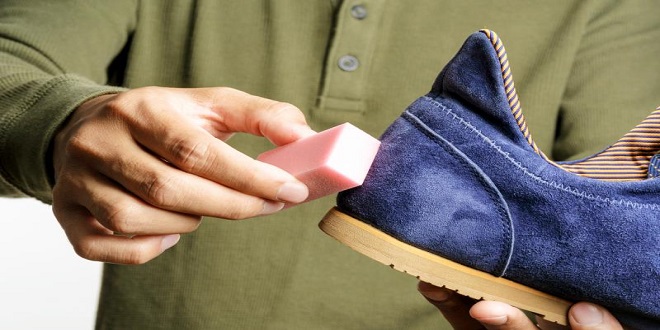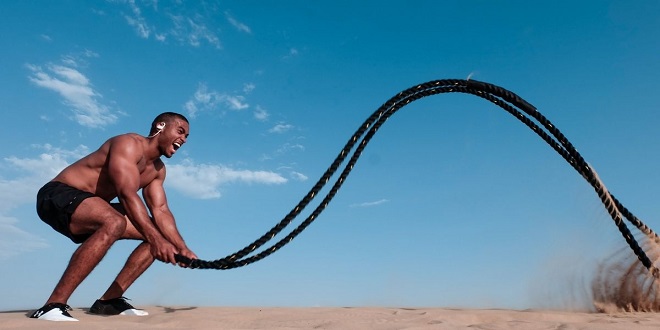The Man’s Guide To Cleaning and Caring For Suede

Suede is a type of leather that’s used for making belts, watches straps, bags and other items. It is most common to be encountered by men in shoes like chukka boots. Suede is a beautiful material that looks and feels great. It adds an interesting visual and tactile texture to footwear and accessories.
Suede can be intimidating for some guys. Perhaps you’ve heard of its delicate nature. It can easily be scratched or scuffed, and can easily be damaged by water, grease and other elements.
Although suede may not be as sensitive as some people believe, it has its own care regimen that is different from other leathers. In a moment, we’ll discuss that. Let’s first look at suede and how it is made. You’ll soon be able to overcome your fear of this beautiful material with both these bits of knowledge.
What is Suede?
If you are anything like me, you might think suede is a different type of leather. — Something man-made, or exotic.
It is actually much simpler than that: leather can be made from any hide (cow, sheep or crocodile). The process of creating suede can be applied to any leather.
Leather manufacturing is complex. Different parts of the hide are used to make different types of leather. Full grain, top grain and bonded leathers are all possible. The hide’s soft side is called suede. Sometimes, manufacturers will flip the hide over. However, this creates stiff material which is not what you want with suede. Red Wing calls it roughout leather. The majority of suede is made from a thin layer of middle that is removed from the hide’s outer part. Suede is thinner and more porous than leather. This results in a napped material which is lighter, softer and more susceptible to damage.
It is important to note that most suede is made of lamb. While other hides are possible, lamb works best for the process. Larger animals produce a shaggier nap which doesn’t look as good.
What about Nubuck?
You’ve probably seen the term “nubuck” when searching for suede. It is actually made from full grain leather and has had its outer layer sanded/buffed to give it some nap. It looks and feels similar to suede but has two major differences. It doesn’t require the same care, but the following routine can still be used. It’s not about which one is better or worse, but what you are looking for in the material.
How to Care For Suede and Make It Last
As we mentioned, suede can be as fragile as you might think. You can easily scrub your shoes with a toothbrush.
It does require care and maintenance, but with a different set of products and processes, than other leathers. You don’t want the bristles of your standard leather care tool to be used on suede.
First, purchase a suede-care kit. A suede-specific kit will include a small brush, and sometimes a second brush for maintaining the nap. It may also include a suede eraser or suede block. It is essentially a large rubber eraser that can remove scuffs. You may also receive a clear spray to protect your leather depending on which kit you have.
Spray the protector immediately after you open your new pair of suede shoes or belts.
To maintain your suede for many years, you can use the following schedule: Once a month for irregular use; once every 1-2 weeks for regular everyday wear.
1. Brush
To remove dirt, sediment, and other particles, use the bristle toothbrush. Do not press too hard or scratch the material. It’s easier to brush your teeth than it is to wash dishes. To keep the nap uniform, you should only brush in one direction.
Brushing can change the color slightly, but it’s only the nap fluctuating. This is similar to what happens when your hands run over suede or velvety couches.
2. Delete
Use the eraser to remove any stains or spots that haven’t been removed by the first brushing. Again, use a light pressure. The eraser can be used to remove almost any stain that isn’t grease (more details below), as well as small scratches and scuffs.
Grease Stains
Grease is one thing that can ruin any suede material. A tiny spot on a shoe or accessory can ruin its uniform appearance. Cornstarch is a product that can help with this type of stain.
You can apply a small amount of cornstarch to the stain. After that, let it sit for at least 15 minutes and absorb the grease. Then brush off with your suede brush. The stain may be removed with just one application. Apply cornstarch again until the stain disappears. Use the eraser to scrub the area. Finally, brush the area with the final brush to remove all residue and restore the nap.
Do not try to use any other grease-fighting agent, such as dish soap. They can cause material damage.
Bonus #1: Cornstarch can be used even on old, seemingly set-in stains. However, it is not guaranteed to work.
Bonus #2: Cornstarch can be applied to any material that has grease. Stinted shirts no longer have to be thrown in the trash.
3. Brush Again
Before and after. You can see small scuffs on the left. The nap is uneven, giving the shoe a slightly splotchy look. After brushing and erasing, you can see that the scuffs have disappeared and the nap is uniform. This gives the shoe a polished appearance. The residue/sediment that is brushed off can be seen on the floor. It really makes a difference and keeps your shoe clean.
Once you have used your eraser, continue to brush the suede in a consistent direction. Use the second brush, often called a “crepe”, if your kit includes one.
4. Spray
Spray a clear protector by holding the item at arm’s reach and spraying it all over. You will see some color changes in the material, but that is normal.
If your suede gets wet, don’t fret. Let it dry if it is just a bit. Then give it a good brushing. If the spray got very wet or muddy, you can dry it with a paper towel and then give it a good clean. You don’t need to be concerned if you have been applying the spray regularly.
You can remove any stain with a brush, eraser or cornstarch. If this happens, find a dry cleaner that works with leather/suede.
Even though suede isn’t a delicate fabric, it can be more easily damaged. You might want to avoid taking chances with the way you wear suede. If the forecast is for rain or you have a muddy adventure in mind, don’t wear the suede boots.
You will enjoy years of enjoyment with your suede products if you do this and follow the maintenance instructions described above.




